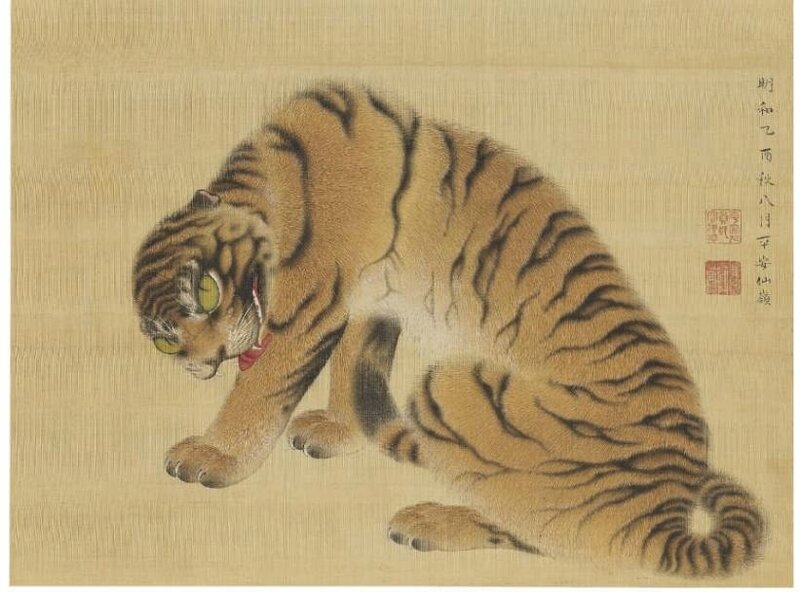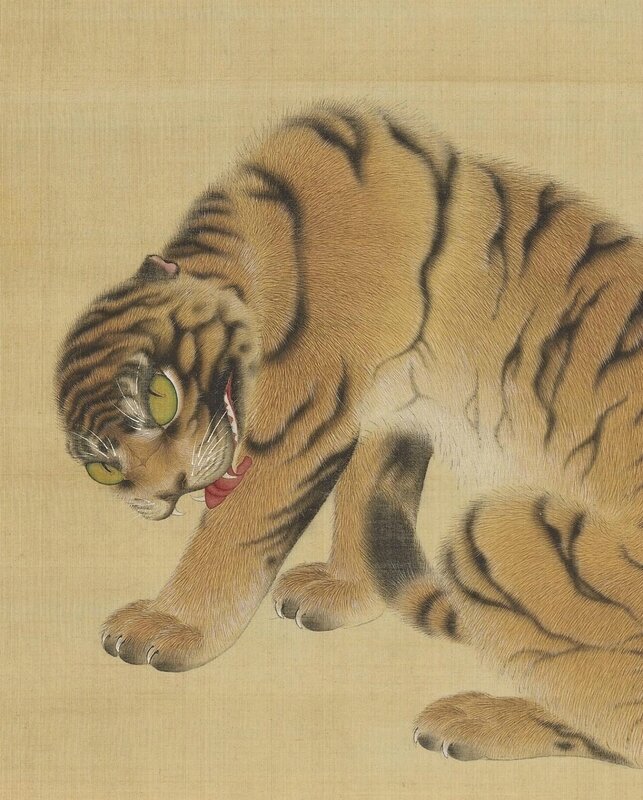Maruyama Okyo (1733-1795), Ferocious Tiger (Mouko zu)
Lot 102. Maruyama Okyo (1733-1795), Ferocious Tiger (Mouko zu). Hanging scroll, ink and colour on silk, signed and dated Meiwa kinototori aki hachigatsu Heian Senryo [Meiwa 2 (1765), August], sealed Heian jininshijichukin and Senryo, 35.8 x 47.5 cm. (painting only), 131 x 63.5 cm. (including silk and brocade mount). Estimate GBP 50,000 - GBP 70,000. Price realised GBP 175,000. © Christie's Images Ltd 2017
Provenance: Duke Matsukata (Matsukata Masayoshi) (1835–1924), whose collection of art was sold in auctions at the Tokyo Bijutsu Club, 26th March and 9th April 1928.
Literature: Tokyo Art Club, ed., Zen-koshaku Matsukata-ke zohin nyusatsu(Duke Matsukata Family collection sale), auction cat., 26th March 1928 (Tokyo, 1928), no. 75
Tobi Kenkyujo and Tokyo Art Club, eds., Tokyo bijutsu shijo-shi (The history of the Tokyo art market), (Tokyo, 1979), pp. 443–44
Sasaki Johei and Sasaki Masako, eds., Kogasoran / Photographic Archive of Japanese Paintings, Maruyama, Shijo School, vol. 1, (Tokyo: Kokusho kankoukai, 2000), p. 576, no. 2430
Kamata Junko, “Maruyama Okyo hitsu Mouko zu“ (Picture of a Ferocious Tiger by Maruyama Okyo), Kokka Seiwaikai 11 (15th May, 2008), color illus., p. 7
Note: In 1928 and 1929, in the wake of a worldwide Depression and countless bank failures, many old collections in Japan were dispersed at auction. This masterful painting of a tiger, only recently “rediscovered,” was sold at auction in 1928 at the Tokyo Art Club. It had been in the collection of Duke Matsukata Masayoshi (1834–1924), the influential finance minister during the Meiji period, responsible for reforming and modernising Japan’s banking system and much more. Matsukata twice served as prime minister during the 1890s. As elder statesman in the period after 1900, he continued to wield power. He had over twenty children. His granddaughter Haru married Edwin Reischauer, the Harvard historian and American ambassador to Japan. His third son, Matsukata Kojiro (1865–1950), who attended Rutgers College, became the president of Kawasaki Shipbuilding Company and is best known for the collection of modern Western painting, sculpture and decorative arts that he assembled in France before World War I, now housed in the National Museum of Western Art in Tokyo. He also amassed thousands of Japanese prints, now in the collection of the Tokyo National Museum.
Okyo was thirty-two (thirty-three by Japanese count) in 1765, when he painted this tiger. Although young, he was already recognized in Kyoto, his hometown, as one of the two or three top artists in the capital. The large-scale works for which he is now best know came much later—the Wisteria screens (1776) in the Nezu Museum, Tokyo, or Pine Trees in Snow, from the 1780s. The tiger, by contrast, is almost miniature in scale. 1765 is in fact the year Okyo gained the devoted patronage of Yujo (d. 1773), the aristocratic thirty-seventh abbot of the Enman-in Temple in Shiga Prefecture, a man deeply invested in positivism and natural history.
Okyo pioneered naturalistic “sketching from life,” a sensational new Western technique that had special appeal to his clients among the newly rich merchant class, collectors who felt uncomfortable with “traditional” art. Tiger imagery has a long history in East Asia. Tigers were frequently paired with dragons—the tiger representing the “male” principle, the yin to the female “yang“ of the dragon, ancient cosmological symbols. Tigers are also commonly paired with bamboo, strong and resilient. Here, however, Okyo eliminates all background noise. He fills the space with the sinuous, elongated creature, exposing the back with its a magnificent pattern of undulating black stripes. With obsessive layering of tiny strokes, Okyo recreates the soft texture of a furry pelt. The hair of the underbelly is painted with white gofun, or powdered oyster shell. As the animal uses its tongue to groom its fur, it glares straight at the viewer. The frighteningly large green eyes are remarkable; they seem to glow.
It is of interest that one of Okyo’s most talented students, Genki (1747–1797), made a quite faithful replica of this painting. Genki was some ten years younger than his teacher, but his painting, now in the Joe and Etsuko Price Collection, might have been painted shortly after he saw the work of his master. Genki could not resist adding some rocks and foliage, and his painting is exactly twice the size of Okyo’s tiger. His beast is more of a pussycat, flattened and decorative.
Christie's. Art of Japan, 5 December 2017, London

/https%3A%2F%2Fprofilepics.canalblog.com%2Fprofilepics%2F1%2F0%2F100183.jpg)
/https%3A%2F%2Fstorage.canalblog.com%2F03%2F02%2F119589%2F96711876_o.jpg)
/https%3A%2F%2Fstorage.canalblog.com%2F11%2F31%2F119589%2F94773502_o.jpg)
/https%3A%2F%2Fstorage.canalblog.com%2F20%2F83%2F119589%2F94772815_o.jpg)
/https%3A%2F%2Fstorage.canalblog.com%2F26%2F72%2F119589%2F75604929_o.jpg)
/https%3A%2F%2Fstorage.canalblog.com%2F59%2F60%2F119589%2F26458628_o.jpg)





/http%3A%2F%2Fstorage.canalblog.com%2F35%2F70%2F119589%2F112637670_o.jpg)
/http%3A%2F%2Fstorage.canalblog.com%2F99%2F60%2F119589%2F76253441_o.jpg)
/http%3A%2F%2Fstorage.canalblog.com%2F32%2F44%2F119589%2F76126892_o.jpeg)
/http%3A%2F%2Fstorage.canalblog.com%2F89%2F15%2F119589%2F74560447_o.jpg)